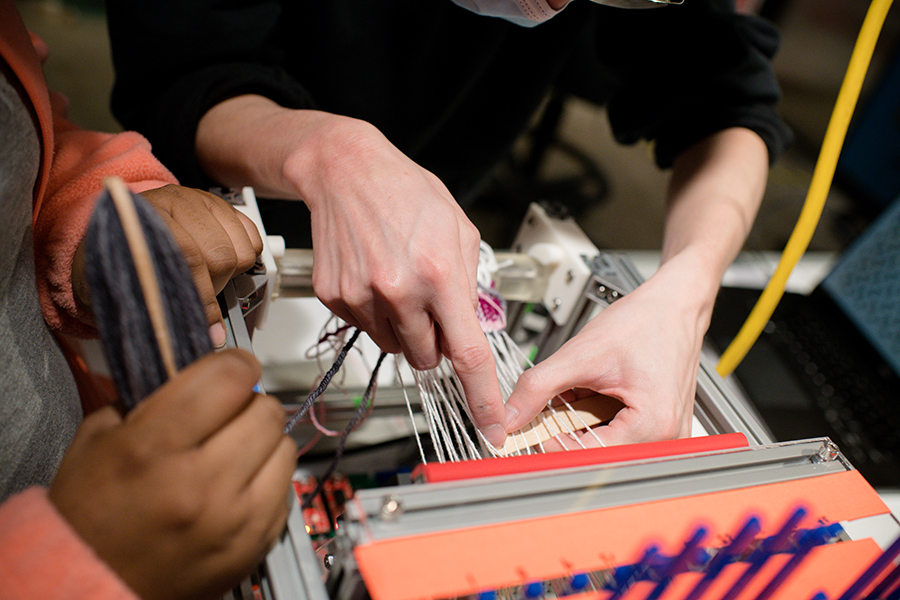
New Course Weaves Math and Engineering Into Art
"Recrafting Soft Technologies" course developed with help from LTI Interim Director Carolyn Rose
For seven weeks this fall, 15 students from the arts and sciences gathered in the basement of Hunt Library constructing robotic looms they used to weave fabrics of their own design during Recrafting Soft Technologies, a new minicourse offered through the School of Computer Science and the Carnegie Mellon University's Integrative Design, Arts and Technology (IDeATe) initiative.
The course used an arts-based approach to teach introductory concepts in computer science, robotics and mechatronics to undergraduates from any discipline across campus. Students watched lectures at home on topics ranging from how weaving works and the properties of thread to electronics and linear algebra, then reported to class each Friday for three hours of hands-on activities related to those lectures. Throughout the minicourse, which began in October and wrapped last week, the teams built their own robotic looms, designed the patterns for their weaving projects and then wove them. They finished the semester by creating interactive cloth, like a piece of clothing with electronics built into it.
"I'm always looking for ways to get more diversity of thought in engineering," said Melisa Orta Martinez, the lead course instructor and an assistant professor in the Robotics Institute (RI). "I do believe that a lot of people maybe feel intimidated from an early age, like they were told they're not good at math and then that's it. A lot of our learning is actually very tactile, but schools don't emphasize that. I'm trying to find ways of teaching the harder concepts, but through playing, touching and device design."
Recrafting Soft Technologies did just that. Students learned basics about electronics before they started assembling their robot looms, when they had to draw on that knowledge to complete the task. Then they moved on to linear algebra and applied it to the fabric design they were creating. Will the cloth be strong enough to stay together or fall apart once it's off the loom? Will it be sturdy or flimsy? How do you decompose that into a mathematical problem?
Teaching a class with such a diverse audience — students came from engineering, computer science, art, art history, design and architecture — wasn't without challenges.
Orta Martinez said she noticed some hesitation from students around the math curriculum at first, but she encouraged them to support each other through "karma points" — extra credit received for helping others. She also operated the class with a focus on kindness. The class was new, and everyone was learning. When she realized around the course's halfway point that four students were still struggling with the math, she asked them to come to office hours to work out the problem together and assured them not to worry about their grades.
"One of them came, and it was awesome because she was scared and didn't know how she was going to do the assignment," Orta Martinez said. "But coming from an art background, she quickly figured out the symmetry and the matrices of the pattern — things that I have a lot of trouble doing if I don't write it out. And I think she got excited by it. It's fascinating how different types of brains approach the problem. That's exciting to see."
The students weren't the only ones to stumble a bit. Orta Martinez quickly realized that she'd made some erroneous assumptions, like underestimating how long it would take teams to assemble their robots.
"It took my graduate student maybe four hours the first time she built it, but she was by herself. So we thought it should take the student teams less time since they have four people helping each other. But we had to spend two classes on that. Two full classes. We need to fix that," she said.
Orta Martinez also plans to revisit how she teaches some of the course's mathematical concepts.
"I think I need to go through more background with them in person. Or plan more activities leading off that. Because I think it's a little hard for them," she said.
Orta Martinez wasn't surprised by the iteration, though, because it's all part of the plan. The course was created in collaboration with colleagues at the University of California Irvine (UCI) and funded in part by a National Science Foundation grant. Carolyn Rosé, a professor in CMU's Human-Computer Interaction Institute and interim director of its Language Technologies Institute, offered a version of the course over the summer, which Orta Martinez refined for this fall with help from IDeATe faculty member Olivia Robinson; RI Ph.D. student Samantha Speer, who designed the course's robotic loom; and Jim McCann, an assistant professor in the RI who helped design the course and the loom. Next semester, Orta Martinez's UCI colleagues, led by faculty member Kylie Peppler, will build upon what she's learned for their spring offering of the same class. Orta Martinez will then use their successes and failures to redesign the course with her colleagues for a full-semester version in fall 2023.
And while the course ostensibly taught students about math and engineering through weaving, at the end of the day it was really exploring how students from different disciplines can help each other learn and solve problems.
"As technology does more and more for us, what other things do people have to learn? We need to know more about different subjects and be able to work with people from different fields," Orta Martinez said. "In every field right now, the way to actually make advances is to understand other fields. So be it art, be it psychology, be it whatever — engineering has to understand the social sciences and arts, and the arts and social sciences have to understand engineering."
